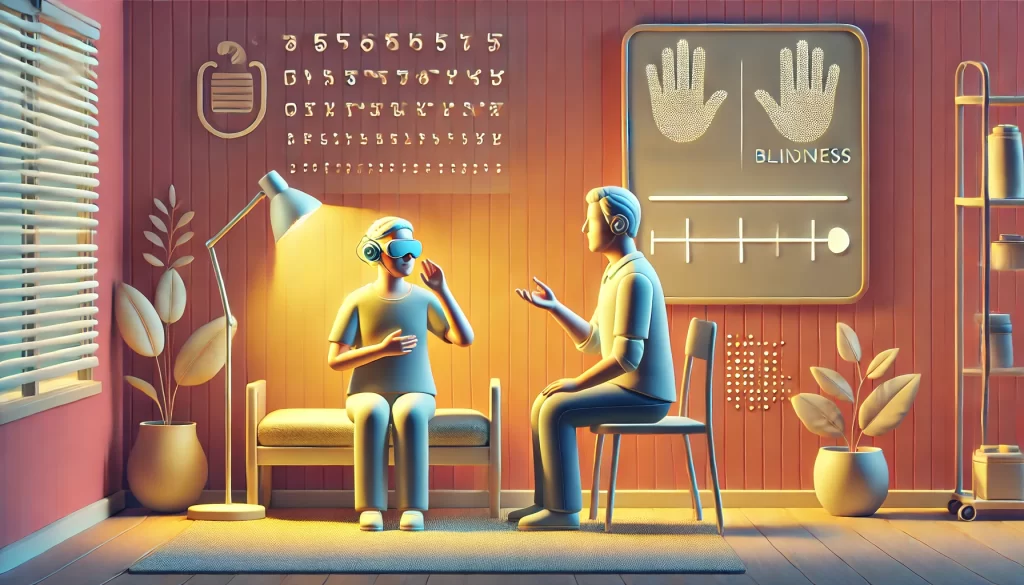About Deafblindness
What is Deafblindness? Deafblindness is a combined loss of hearing and vision that significantly impacts a person’s ability to communicate, access information, and navigate their environment. It is also known as “dual sensory loss” or “multi-sensory impairment.” Most deafblind individuals are not completely deaf and blind; instead, both senses are sufficiently impaired to create substantial daily challenges, as hearing and vision typically complement one another.
Signs of Deafblindness While deafblindness can affect people of all ages, it is most common among older adults and may develop gradually. Individuals may not immediately notice the decline in their hearing and vision. Signs to watch for include:
- Turning up the volume on devices such as the television or radio.
- Struggling to follow conversations.
- Not hearing everyday sounds, like a knock at the door.
- Asking people to speak more loudly, slowly, or clearly.
- Holding reading materials close to the face or sitting very close to the TV.
- Difficulty navigating unfamiliar surroundings.
If someone already experiences hearing or vision issues, it is important to monitor for signs that the other sense may also be declining.
When to See a GP You should visit your GP if you notice a decline in your hearing or eyesight. If you are concerned about someone else, encourage them to speak with their GP. Early intervention and diagnosis can improve treatment outcomes for underlying causes of deafblindness and help individuals access local support services sooner.
Causes of Deafblindness Deafblindness can arise from various causes, including:
- Age-related hearing loss: A common cause of sensory decline among older people.
- Genetic conditions, such as Usher syndrome.
- Infections during pregnancy, such as rubella (German measles).
- Cerebral palsy, which affects the brain and nervous system, primarily impacting movement and coordination.
- Age-related eye conditions, such as cataracts.
Living with Deafblindness Support and care services are available to assist deafblind individuals, who may have varying degrees of hearing and vision loss. Care plans should be tailored to each person’s unique needs, with the main goals being to:
- Preserve remaining senses: This can include treating underlying conditions (e.g., cataracts), wearing glasses, or using hearing aids.
- Teach alternative communication methods: This might involve learning hand-on-hand signing, braille, or other adaptive methods.
- Promote independence: Support may include training with a long cane, guide dogs, or the assistance of a communicator guide.
Local authorities can conduct assessments to determine what care and support each person needs, ensuring their specific challenges are addressed.
Signs and symptoms of deafblindness
Deafblindness, which involves a combination of hearing and vision loss, can significantly impact everyday life and communication. Here are some signs and symptoms to be aware of, especially in cases where the issues may develop gradually:
Signs of a Hearing Problem:
- Difficulty hearing someone speaking from behind.
- Frequently needing to turn up the volume on devices like the television or radio.
- Challenges following conversations, especially in group settings or with unfamiliar speakers.
- Not hearing common noises, like a knock at the door or a ringing doorbell.
- Asking people to speak louder, slower, or more clearly.
- Leaning in closely to hear what is being said.
If someone already has a known hearing issue, be mindful of any vision changes.
Signs of a Vision Problem:
- Difficulty seeing in dim or very bright light.
- Struggles with recognizing people they know.
- Trouble reading facial expressions.
- Increased reliance on touch to find or identify objects.
- Holding reading materials very close to the face or sitting close to the TV.
- Bumping into or tripping over objects in unfamiliar places.
- Avoiding direct eye contact or not looking at people during conversations.
If someone already has known vision issues, watch for potential signs of hearing loss.
Seeking Medical Advice:
If you or someone you know is experiencing these symptoms, it’s crucial to visit a GP for assessment. Early diagnosis can lead to more effective treatments for underlying conditions and provide access to necessary support services, such as learning new communication methods. Early intervention is key to maintaining independence and quality of life. Encourage friends or family members showing these symptoms to seek medical advice promptly.
Causes of deafblindness
Deafblindness, a condition affecting both vision and hearing, can have a range of causes. It can be present from birth or develop later in life.
Causes of Deafblindness Present from Birth (Congenital Deafblindness):
- Premature Birth: Health issues related to birth occurring before 37 weeks of pregnancy can contribute to deafblindness.
- Infections During Pregnancy: Certain infections, such as rubella (German measles), toxoplasmosis, or cytomegalovirus (CMV), can impact the development of a baby and lead to deafblindness.
- Genetic Conditions: Conditions such as CHARGE syndrome and Down’s syndrome can be associated with deafblindness.
- Cerebral Palsy: This neurological disorder primarily affects movement and coordination but can also result in sensory impairments.
- Foetal Alcohol Syndrome: Health problems in babies born to mothers who consumed alcohol during pregnancy can include sensory issues, such as deafblindness.
Causes of Deafblindness Developing Later in Life (Acquired Deafblindness):
- Age-Related Hearing Loss: Gradual hearing decline with age can contribute to deafblindness if combined with vision loss.
- Usher Syndrome: This genetic condition affects hearing, vision, and sometimes balance.
- Age-Related Eye Problems: Conditions like age-related macular degeneration (AMD), cataracts, and glaucoma can lead to vision impairment.
- Diabetic Retinopathy: High blood sugar levels associated with diabetes can damage the retina, leading to vision loss.
- Brain Damage: Conditions like meningitis, encephalitis, strokes, or severe head injuries can impact both hearing and vision capabilities.
Understanding the cause of deafblindness can be crucial for effective diagnosis, support, and treatment planning. If you or someone you know is experiencing symptoms of deafblindness, seeking medical advice is essential for accessing appropriate care and support services.
Diagnosing deafblindness
Diagnosing deafblindness involves a range of checks and assessments, and it can be identified soon after birth or later in life through various tests.
Newborn Screening:
- Routine Checks at Birth: If a baby is born with deafblindness, it is often detected through standard newborn screening tests. These tests aim to identify serious health issues from birth, including any hearing or vision problems.
- Routine Monitoring as the Child Grows: If issues are not evident at birth, they may be picked up during standard developmental checks as the child grows.
Hearing and Vision Tests for Adults:
- Gradual Onset: Deafblindness often develops over time, especially as a person ages. It may happen so gradually that individuals may not immediately notice any decline.
- Regular Eye Tests: It’s recommended that adults have their eyes checked every two years to detect any developing vision problems.
- Hearing Tests: You can request a hearing test through your GP at any time if you suspect hearing loss. Routine tests help to monitor changes over time.
Diagnosing Deafblindness:
- Dual Sensory Loss: If tests confirm issues with both hearing and vision, a diagnosis of deafblindness may be made.
- Regular Monitoring: Once diagnosed, a person’s hearing and vision should be continuously monitored. The care and support provided will be adjusted according to the severity of their sensory loss.
Specialist Assessment:
- Arranged by Local Authority: When deafblindness is identified, a specialist assessment will be arranged by the local authority.
- Assessment by a Specialist: Only a specially trained professional should carry out the assessment, considering the person’s:
- Communication needs
- One-to-one human contact
- Social interaction
- Emotional wellbeing
- Mobility support
- Assistive technology requirements
- Rehabilitation services
- Customized Care: The assessment ensures that the deafblind individual receives care tailored to their specific level of hearing and sight loss, taking into account both their current and future needs.
Access to Appropriate Services:
- Specialized vs. Mainstream Services: Deafblind individuals may need specialized services rather than mainstream services designed solely for blind or deaf people, to accommodate their unique needs.
Managing deafblindness
Managing deafblindness involves providing tailored care and support services aimed at helping individuals maximize their remaining sensory functions, develop alternative communication methods, and maintain as much independence as possible.
Individual Care Plan:
- Assessment: Each deafblind person’s unique needs and abilities are assessed after diagnosis to create a customized care plan.
- Objectives: The care plan may focus on preserving remaining sensory functions, teaching communication methods such as the deafblind manual alphabet, and promoting independence through training with a long cane, guide dog, or a communicator guide.
- Support for Young Children: Ensures their educational needs are addressed.
Communication Systems:
Deafblindness can make speech and writing challenging, so alternative forms of communication may be necessary:
- Clear Speech: Speaking clearly for those with some residual hearing and vision.
- Deafblind Manual Alphabet: A tactile method where words are spelled out on the person’s hand using set movements.
- Block Alphabet: Words are traced onto the person’s palm using capital letters.
- Hands-on Signing: The deafblind person feels the signs by placing their hands on the signer’s hand.
- Visual Frame Signing: Adjusts British Sign Language (BSL) to fit within the remaining visual field of the person.
- Braille and Moon: Raised dots or adapted capital letters for tactile reading.
Vision Aids:
- Low Vision Aids: Glasses, magnifying lenses, and task lights to improve vision.
- Assistive Devices: Special telephones, keyboards, and other tools for visually impaired people.
Hearing Aids and Implants:
- Hearing Aids: Amplifies sound for those with residual hearing. An audiologist can recommend the most suitable type.
- Implants: Cochlear implants or bone-conducting hearing implants may be used for those unable to use standard hearing aids.
One-to-One Support:
Deafblind individuals may be entitled to a one-to-one support worker, such as:
- Communicator Guides: Support those who became deafblind later in life to maintain independence.
- Interpreters: Facilitate communication using the person’s preferred method.
- Intervenors: Work with people born deafblind to help them engage with their surroundings.
Treating Underlying Conditions:
Some causes of deafblindness can be treated with medication or surgery:
- Cataracts: Treatable through surgical lens implantation.
- Glaucoma: Managed with eye drops or laser surgery.
- Diabetic Retinopathy: Early stages may be treated with laser surgery.
- Hearing Loss Causes: Temporary issues like earwax buildup or middle ear infections can be treated.
Want to Learn More?
- Sense offers resources on assistive technology and one-to-one support.
- RNIB and RNID provide guidance on assistive aids, hearing aids, and related technology.







